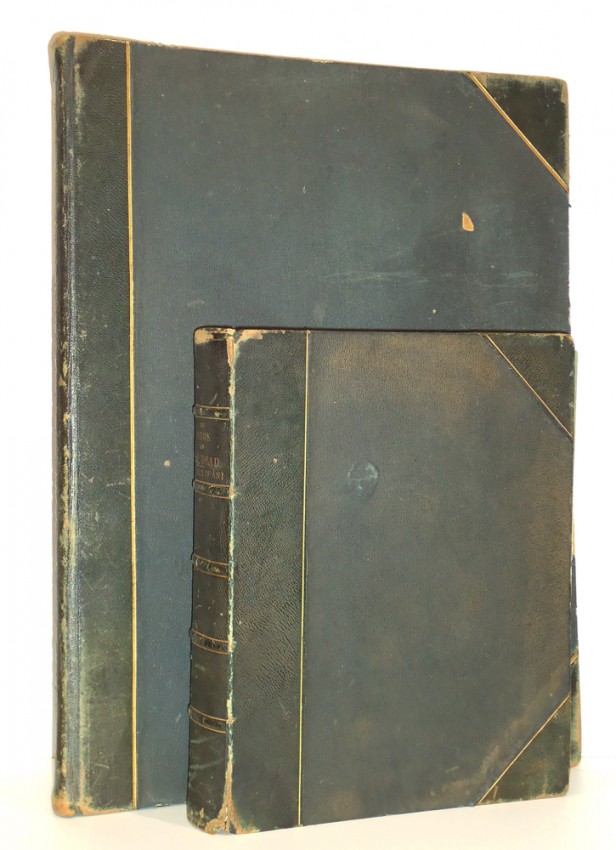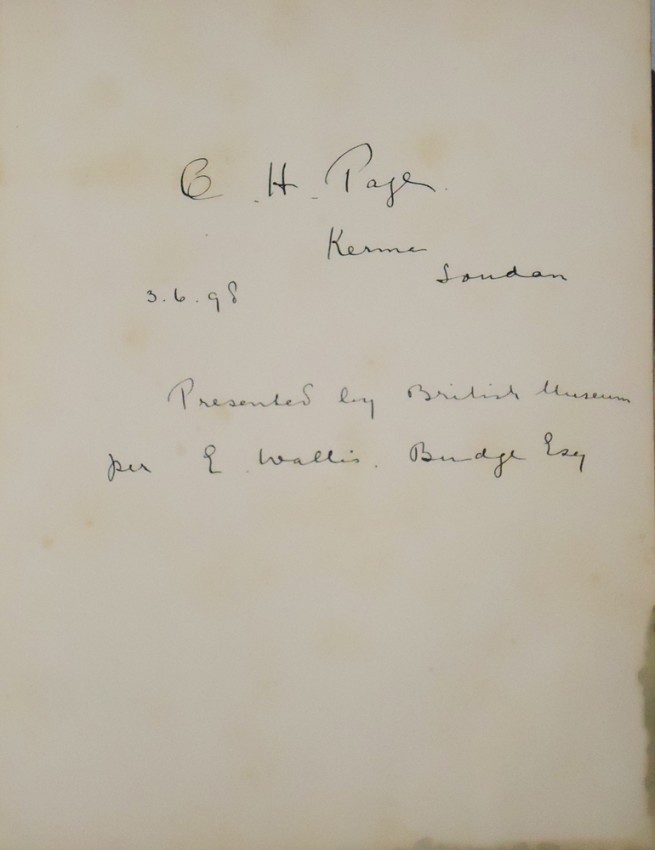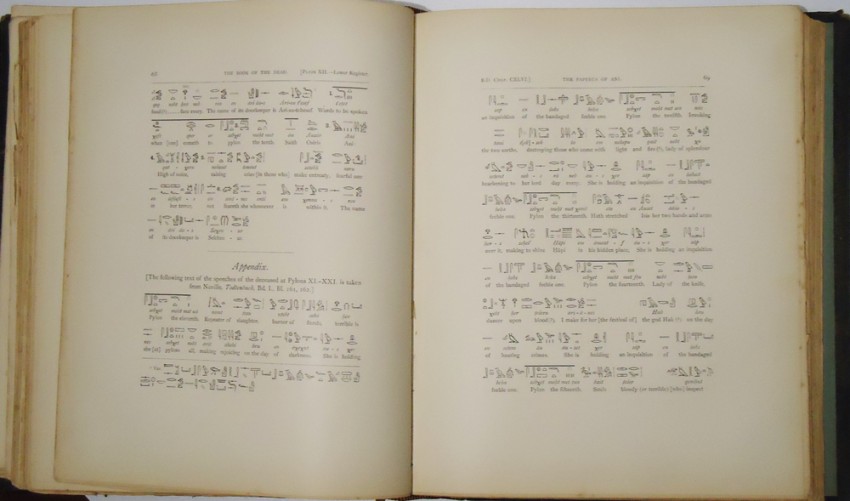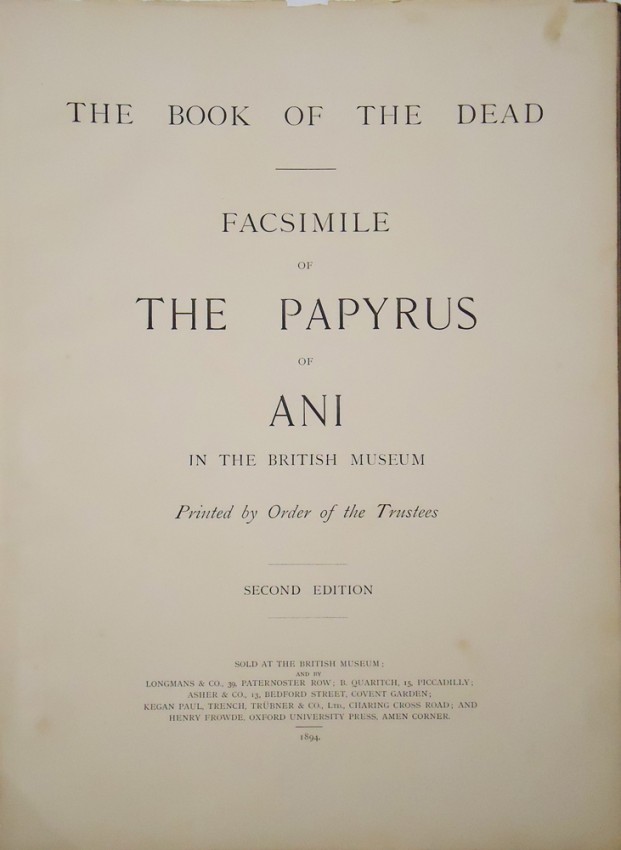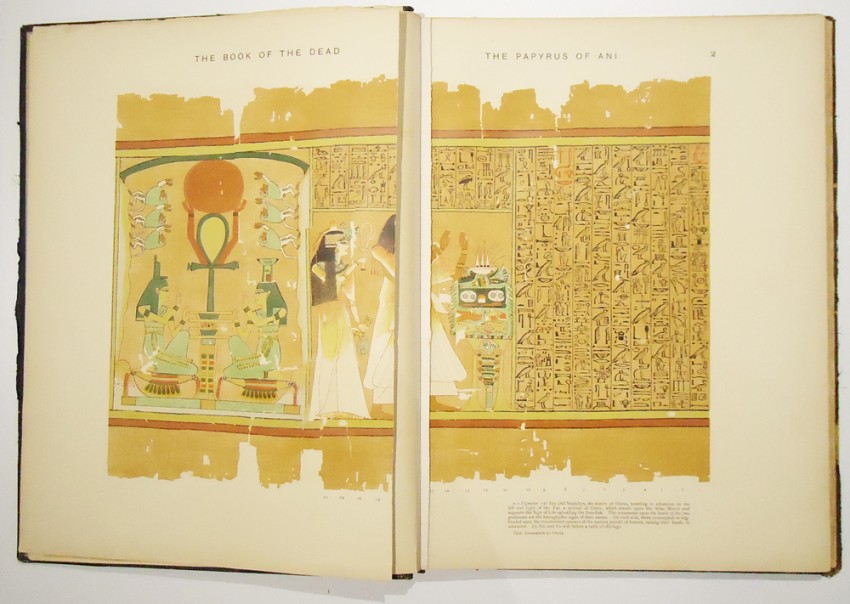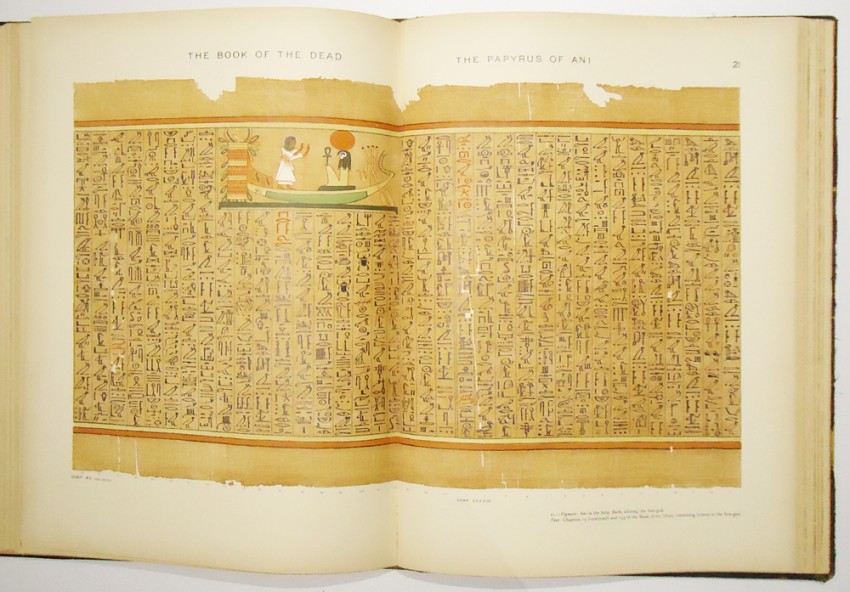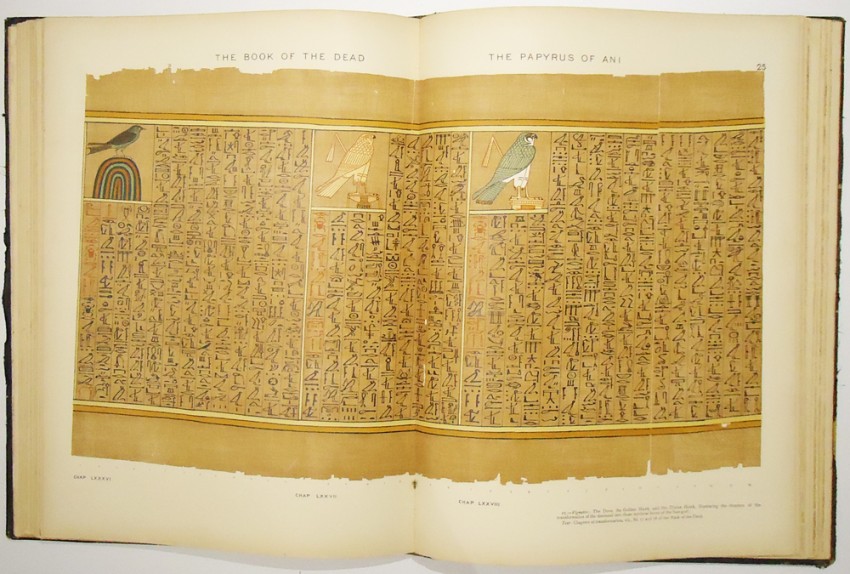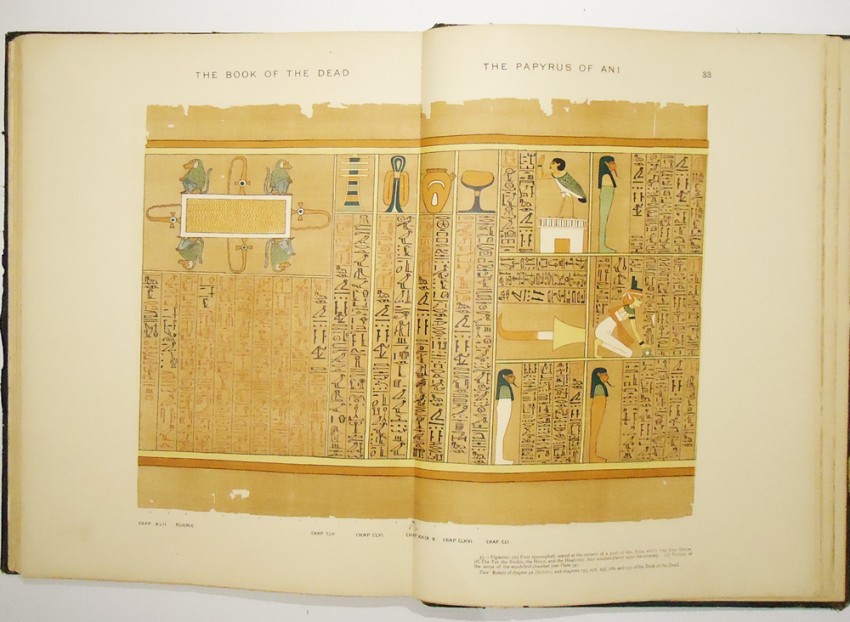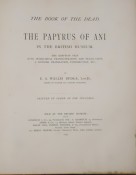Volume 1: The Egyptian text with interlinear transliteration and translation, a running translation, introduction etc., by E.A.Wallis Budge
Volume 2: The Facsimile of the Papyrus of Ani
Printed by order of the Trustees.
Complete two-volume set of The Book of the Dead consisting of a Text volume, and a Facsimile volume:
First edition Text volume: clv, [1], 377, [1]pp, original half dark green leather over pebble grained boards, there is a mark on the front cover, titled gilt on the spine which is split at the top and the bottom, uncut edges, pages starting to detach at the front hinge and some sections loose.
Second edition: Facsimile volume: vii, [1] + 37 double page numbered coloured plates mounted on cloth hinges - plate 2 is split at the fold and it now in two parts and with a tear repaired with tape from the back which is browned but does not show through, some tears in the margins of other plates but overall they are bright and without foxing, half dark green leather over pebble grained boards, the boards are chipped and worn at the edges, and the leather is scuffed.
The first volume was published to accompany the second Facsimile edition of the Papyrus of Ani which was originally published in 1890 without any text volume. This book contains the hieroglyphic text of the Papyrus with interlinear transliteration and word for word translation, a full description of the vignettes, and a running translation: and in the Introduction, an attempt has been made to illustrate from native Egyptian sources the religious views of the people who more than five thousand years ago proclaimed the resurrection of a spiritual body and the immortality of the soul.
The inscription on a front free end paper reads: C.H. Page Kerma Soudan (sic) 3.6.98 Presented by the British Museum per E. Wallis Budge Esq.
The Papyrus of Ani, was found at Thebes, and was purchased by the Trustees of the British Museum in 1888. It measures 78 feet by 1 foot 3 inches, and is the longest known papyrus of the Theban period. It is made up of six distinct lengths of papyrus, which vary in length from 26 feet 9 inches to 5 feet 7 inches. The material is composed of three layers of papyrus supplied by plants which measured in the stalks about 41 inches in diameter. The several lengths have been joined together with great neatness, and the repairs and insertion of new pieces (see plates 25, 26) have been dexterously made. When first found, the papyrus was of a light colour, similar to that of the papyrus of Hunefer (B. M. No. 9901), but it became darker after it had been unrolled, and certain sections of it have shrunk somewhat.
It contains a number of chapters of the Book of the Dead, nearly all of which are accompanied by vignettes; and at top and bottom is a border of two colours-red and yellow. At the beginning and end of the papyrus spaces of six and eleven inches respectively have been left blank. The inscribed portion is complete, and the loss of the few characters which were damaged in unrolling does not interrupt the text. It was written by three or more scribes; but the uniformity of the execution of the vignettes suggests that fewer artists were employed on the illustrations. The titles of the chapters, rubrics, catchwords, etc., are in red. In some instances the artist has occupied so much space that the scribe has been obliged to crowd the text (e.g., in plate 11) and at times he has written it on the border (see plates 14, 17). This proves that the vignettes were drawn before the text was written.
All the different sections of the papyrus were not originally written for Ani, for his name has been added in several places' by a later hand. The papyrus of Ani is undated, and no facts are given in it concerning the life of Ani, whereby it would be possible to fix its exact place in the series of the illustrated papyri of the Theban period to which it belongs. http://www.sacred-texts.com/egy/ebod/ebod12.htm
Kerma (also known as Dukki Gel) was the capital city of the Kerma Culture, which was located in present-day Sudan at least 5500 years ago.Kerma is one of the largest archaeological sites in ancient Nubia. It has produced decades of extensive excavations and research, including thousands of graves and tombs and the residential quarters of the main city surrounding the Western/Lower Deffufa. Around 3000 BC, a cultural tradition began around Kerma. It was a large urban center that was built around a large adobe temple known as the Western Deffufa. As a capital city and location of royal burials, it sheds light on the complex social structure present in this society. https://en.wikipedia.org/wiki/Kerma
Sir Ernest A T Wallis Budge was born 27 July 1857 in Bodmin, Cornwall; taught himself Hebrew and Syriac, and copied cuneiform inscriptions at The British Museum, before going to study Semitic languages at Christ's College Cambridge from October 1878, and where he became Tyrwhitt Hebrew scholar. He joined The British Museum as an assistant in 1883 and where he eventually became Keeper of Egyptian and Assyrian Antiquities from 1894-1924. As early as 1886 he visited Egypt under instructions to supply antiquities to the BM. Died 23 November 1934.
He was a Fellow of the Society of Antiquaries and was knighted in 1920. He married Dora Helen Emerson on 24 March 1883. Budge energetically acquired a large number of antiquities and manuscripts during the course of his work in Egypt and Mesopotamia. His three trips to these countries in 1887, 1888 and 1890 are described rather colourfully in his book 'By Nile and Tigris' (London, 1920). He gained the Arabic nicknames of "Father of Skulls" and "Father of Antiquities" as a direct result of his collecting activities in Egypt and Sudan. He was a prolific writer on Assyriological and Egyptological matters, and edited Syriac and Ethiopian manuscripts.
Author of: 'The Nile: Notes for Travelllers in Egypt', London: Thomas Cook & Co., 1890; 'The Egyptian Sudan: Its History and Monuments', London: Kegan Paul (two volumes), 1907; 'By Nile and Tigris. A narrative of journeys in Egypt and Mesopotamia on behalf of the British Museum between the years 1886 and 1913', London: John Murray, 1920 (two volumes); 'The Rise and Progress of Assyriology', London: Martin Hopkinson, 1925; '"Mike" the Cat Who Assisted in Keeping the Main Gatye of the British Museum from 1909 to January 1929', London: privately published, 1929. http://www.britishmuseum.org/research/search_the_collection_database/term_details.aspx?bioId=93650
- Overall Condition: A Very Good Set
- Size: Folio + Elephant folio
- Sold By: Clarke's Africana & Rare Books
- Contact Person: Paul Mills
- Country: South Africa
- Email: [email protected]
- Telephone: 021 794 0600
- Preferred Payment Methods: Visa & Mastercard via PayGate secure links and Bank transfers.
- Trade Associations: ABA - ILAB, SABDA


